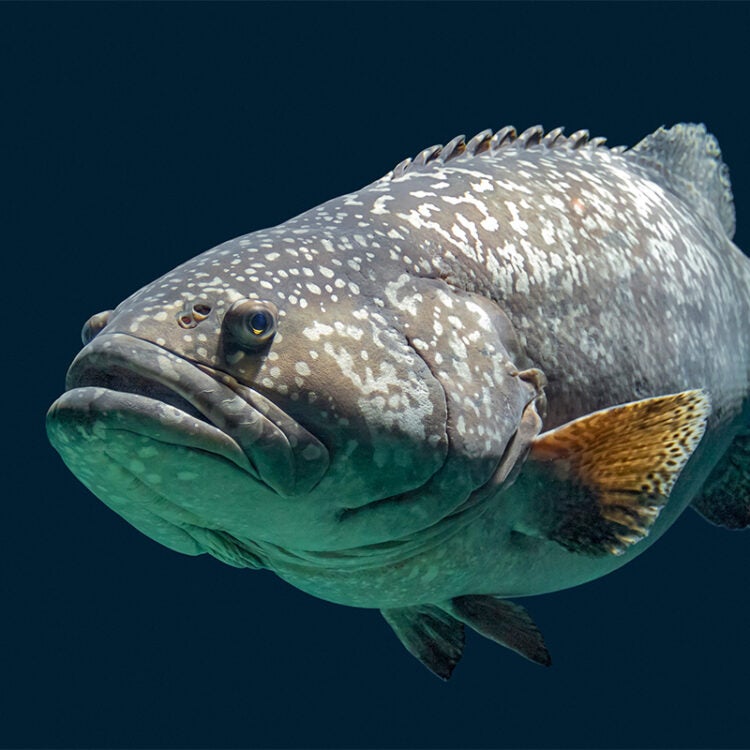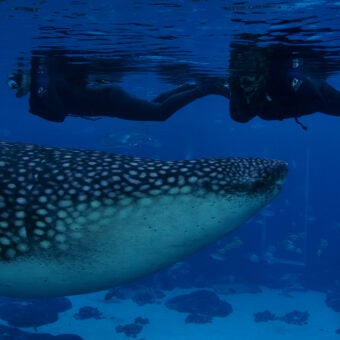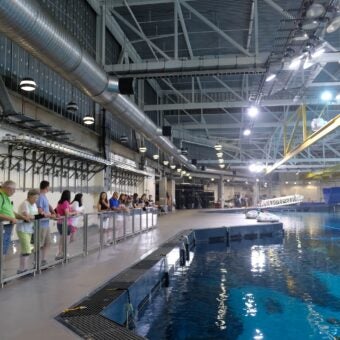-
Size
6.2 feet (1.9 m) -
Diet
Fish, sharks, juvenile sea turtles and crustaceans -
Range
Indo-Pacific -
Habitat
Tropical shallow reefs, caves, wrecks and estuaries
Physical Characteristics
- Largest of all coral reef-dwelling bony fish.
- Common length of 6.2 feet (1.9 m), with a maximum length of 9 feet (2.7 m).
- One of the largest recorded was 9.8 feet (3 m) and weighed more than 882 lbs. (400 kg).
- Has a very large mouth that expands and protrudes to create a strong suction to draw in prey.
- The mouth has at least seven rows of teeth in the middle of the lower jaw.
- The giant grouper’s eyes function effectively in dim light, which gives it an advantage over its prey during dawn and dusk feeding times.
- Eyes also rotate so grouper can see approaching prey without moving its head.
- Juvenile giant grouper are bright yellow with large, irregular black or dark brown bars.
- As adults, irregular patterns break up and their coloring becomes a muted, mottled olive-gray.
Animal Fun Fact
Giant groupers can reach up to 9 feet (2.7 m) in length.
Diet / Feeding
- Consists of fish, sharks, juvenile sea turtles and crustaceans, including spiny lobsters and mud crabs.
- Ambush predator that lies in wait while hiding in holes, crevices and reef overhangs.
- Swallows food whole.
- Occupies the upper end of the food chain.
- Few reside in each area; few are found on any one reef.
Range / Habitat
- Occurs in the Indo-Pacific from the Red Sea to Algoa Bay, South Africa through the Hawaiian and Pitcairn islands and also Australia.
- Found in tropical shallow reefs, caves, wrecks and estuaries commonly to 164 feet (50 m) deep. The full depth range is 13-328 feet (4-100 m).
Reproduction & Growth
- Protogynous hermaphrodite; starts out life as a female and can later change gender to become male.
- Does not reach sexual maturity until it is about 20 years old. Fishing usually removes the largest, and therefore oldest, fish first.
Conservation Status
- “Data Deficient” on IUCN Red List.
- The population is thought to be declining 20 percent rate every ten years.
- Populations of this species have been drastically reduced worldwide due to overfishing but long-term quantitative data are not available across a large portion of its range.
Additional Information
- Slow-growing and lives up to or beyond 50 years.
- Other common names for this species are “Queensland grouper” and “brindle bass.”
Sources
- Encyclopedia of Fishes. 2nd Edition, pgs. 195 -199
- Fishes of the Great Barrier Reef. Randall, J. E., pg. 109
- Fishes of the Tropical Eastern Pacific. Allen, G. R., pg. 106
- Reef Fish. Thresher, R. E., pgs. 153 -155
-







